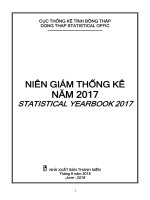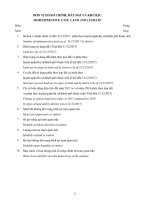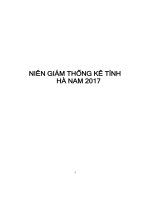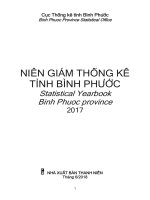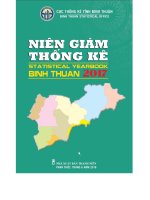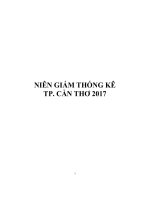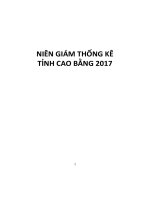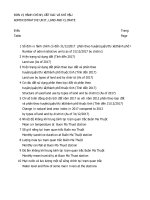Niên giám thống kê tỉnh bạc liêu 2019 bac lieu statistical yearbook 2019
Bạn đang xem bản rút gọn của tài liệu. Xem và tải ngay bản đầy đủ của tài liệu tại đây (2.6 MB, 523 trang )
2020
2020
1
Chỉ đạo biên soạn:
NGUYỄN THANH HẢI
Phó Cục trưởng Cục Thống kê tỉnh Bạc Liêu
Tham gia biên soạn:
PHÒNG THỐNG KÊ TỔNG HỢP
VÀ CÁC PHÒNG NGHIỆP VỤ
Cục Thống kê tỉnh Bạc Liêu
2
LỜI NÓI ĐẦU
Niên giám Thống kê là ấn phẩm tổng hợp số liệu kinh tế - xã hội
hàng năm của ngành Thống kê. Nội dung niên giám là bức tranh toàn
cảnh từ đơn vị hành chính, đất đai, khí hậu, đến tình hình dân số, lao
động và các hoạt động kinh tế - xã hội trong một năm.
Cục Thống kê tỉnh Bạc Liêu biên soạn và phát hành “Niên giám
Thống kê tỉnh Bạc Liêu năm 2019”, bao gồm hệ thống số liệu phản ánh
kết quả đã thực hiện trên các lĩnh vực kinh tế, văn hóa và đời sống xã hội
của địa phương từ năm 2015 - 2019. Sử dụng hệ thống số liệu giúp các
nhà quản lý, nghiên cứu, các tổ chức và cá nhân có nhu cầu dùng tin
phân tích, đánh giá về quá trình phát triển kinh tế - xã hội địa phương;
Các cấp lãnh đạo, các ban, ngành… hoạch định, lập kế hoạch, quy
hoạch đưa ra chủ trương, chính sách và những giải pháp phát triển kinh
tế - xã hội cho năm 2020 và các năm tiếp theo.
Trong cuốn Niên giám này, Cục Thống kê tỉnh Bạc Liêu có chỉnh lý
số liệu theo phương pháp tính và chuyển giá so sánh theo năm gốc 2010.
Do vậy, số liệu có sự điều chỉnh với niên giám năm trước, đề nghị thống
nhất sử dụng số liệu trong cuốn Niên giám năm 2019.
Q trình biên soạn khó tránh khỏi những hạn chế, thiếu sót, rất
mong nhận được ý kiến đóng góp của quý lãnh đạo và bạn đọc về nội
dung cũng như hình thức đối với ấn phẩm để lần biên soạn sau được
hồn chỉnh và phong phú hơn.
Mọi góp ý trao đổi, vui lòng liên hệ phòng Tổng hợp, Cục Thống kê
tỉnh Bạc Liêu, số 112, Bà Triệu, phường 3, thành phố Bạc Liêu, tỉnh
Bạc Liêu, điện thoại 02913.949304./.
CỤC THỐNG KÊ TỈNH BẠC LIÊU
3
FOREWORD
Statistical Yearbook is a publication which is aggregated the annual
socio-economic data of Viet Nam Statistical System. Its content includes
the total aspects, from administrative, land and climate to situation of
population, labor and socio-economic activities in a year.
Bac Lieu Statistics Office compiles and publishes the book
“Bac Lieu Statistical Yearbook 2019” which includes the data system
reflecting the results achieved in the fields of economics, culture and
social life of the locality from 2015 - 2019. Using the data system to help
managers, researchers, organizations and individuals wishing to use
information to analyze and assess the local socio-economic development
process; The leaders, departments, sectors... make planning, give
guidelines, policies and solutions for socio-economic development for
2020 and the following years.
In this yearbook, Bac Lieu Statistical Office has revised the data
according to the method of calculating and transferring the comparative
prices by the year 2010. Therefore, the data was adjusted with the
previous yearbook, statistical data users should use the data in the 2019
Yearbook.
In the process of compiling, mistake is unavoidable. We are looking
forward to receiving comments and ideas from the leaders and readers in
both content and form of publications so that statistical yearbook is more
complete and better in the next release.
If there is any issue in process of using, please feel free to contact
Integrated Division, the Bac Lieu Statistics Office, located at 112, Ba Trieu,
Ward 3, Bac Lieu City, Bac Lieu Province; Telephone: 02913.949.304./.
BAC LIEU STATISTICS OFFICE
4
MỤC LỤC
CONTENT
Trang
Page
Lời nói đầu
Foreword
3
4
Tổng quan kinh tế - xã hội tỉnh Bạc Liêu năm 2019
Overview on socio-economic situation in Bac Lieu province in 2019
7
16
Đơn vị hành chính, đất đai và khí hậu
Administrative unit, land and climate
27
Dân số và lao động - Population and Labour
45
Tài khoản quốc gia và ngân sách Nhà nước
National accounts and State budget
95
Đầu tư và xây dựng - Investment and Construction
131
Doanh nghiệp, hợp tác xã và cơ sở SXKD cá thể
Enterprise, cooperative and individual business establishment
163
Nông nghiệp, lâm nghiệp và thủy sản
Agriculture, forestry and fishing
273
Công nghiệp - Industry
341
Thương mại và du lịch - Trade and tourism
367
Chỉ số giá - Price index
389
Vận tải, bưu chính và viễn thơng
Transport, postal services and tele-communications
415
Giáo dục, đào tạo và khoa học, công nghệ
Education, training and science, technology
435
Y tế, thể thao, mức sống dân cư, trật tự, an toàn xã hội, tư pháp
và môi trường
Health, sport, living standards, social order, safety, justice
and environment
477
5
6
TỔNGQUANKINHTẾ‐XÃHỘITỈNHBẠCLIÊU
NĂM2019
1. Tăng trưởng kinh tế
Tổng sản phẩm trong tỉnh (GRDP) năm 2019 ước tính tăng
10,61% so với năm 2018. Trong mức tăng 10,61% của tồn nền kinh
tế, khu vực nơng, lâm nghiệp và thủy sản tăng 6,05%, đóng góp 2,77
điểm phần trăm vào mức tăng chung; khu vực công nghiệp và xây
dựng tăng 19,33%, đóng góp 3,27 điểm phần trăm; khu vực dịch vụ
tăng 12,78%, đóng góp 4,11 điểm phần trăm; thuế sản phẩm trừ trợ
cấp sản phẩm tăng 9,03%, đóng góp 0,46 điểm phần trăm.
Tổng sản phẩm (GRDP) theo giá hiện hành đạt 46.375,62
tỷ đồng; GRDP bình quân đầu người ước tính đạt 51,06 triệu đồng.
Cơ cấu nền kinh tế năm 2019 tiếp tục chuyển dịch theo hướng công
nghiệp hóa, trong đó khu vực nơng, lâm nghiệp và thủy sản chiếm tỷ
trọng 42,96%; khu vực công nghiệp và xây dựng chiếm 18,54%; khu
vực dịch vụ chiếm 33,50%; thuế sản phẩm trừ trợ cấp sản phẩm
chiếm 5% trong tổng cơ cấu chung của toàn ngành kinh tế.
2. Thu, chi ngân sách và bảo hiểm
Năm 2019, tổng thu ngân sách Nhà nước trên địa bàn tỉnh Bạc
Liêu ước đạt 7.414,38 tỷ đồng, bằng 69,84% so với cùng kỳ.
Tổng chi ngân sách trên địa bàn tỉnh Bạc Liêu đạt 7.166,49 tỷ đồng,
bằng 79,73% so với cùng kỳ. Trong đó, chi đầu tư phát triển 1.833,32
tỷ đồng, bằng 67,01% so cùng kỳ; chi thường xuyên 4.288,05 tỷ đồng,
tăng 5,42%; chi bổ sung quỹ dự trữ tài chính 1 tỷ đồng, bằng 13,76%
so với cùng kỳ…
Tổng số thu bảo hiểm năm 2019 đạt 1.244 tỷ đồng, tăng 2,64%
so với năm 2018, trong đó: Thu bảo hiểm xã hội, đạt 572 tỷ đồng,
tăng 10,64%; bảo hiểm y tế là 634 tỷ đồng, bằng 95,92% so cùng kỳ;
7
bảo hiểm thất nghiệp là 38 tỷ đồng, tăng 11,76% so cùng kỳ. Tổng số
chi bảo hiểm năm 2019 là 1.571 tỷ đồng, tăng 11,18% so với cùng kỳ,
trong đó chi bảo hiểm xã hội là 540 tỷ đồng, tăng 17,14%; chi bảo
hiểm y tế 987 tỷ đồng, tăng 7,99%; chi bảo hiểm thất nghiệp 44 tỷ
đồng, tăng 15,79% so cùng kỳ.
3. Đầu tư - xây dựng
Tổng vốn đầu tư thực hiện toàn xã hội tỉnh Bạc Liêu năm 2019
theo giá hiện hành đạt 23.882,38 tỷ đồng, tăng 32,32% so với năm
2018, bao gồm: Vốn khu vực Nhà nước đạt 3.475,55 tỷ đồng (chiếm
14,55% tổng vốn đầu tư thực hiện toàn xã hội), tăng 12,17% so cùng
kỳ; khu vực ngoài Nhà nước đạt 20.290,69 tỷ đồng (chiếm 84,96%),
tăng 36%; khu vực có vốn đầu tư nước ngồi đạt 116,14 tỷ đồng,
(chiếm 0,49%), tăng hơn 2,7 lần so năm trước.
Về thu hút đầu tư trực tiếp nước ngoài: Năm 2019, tỉnh có 03 dự
án vốn đầu tư trực tiếp nước ngồi mới được triển khai với tổng vốn
đầu tư đăng kí 113,51 triệu USD.
4. Chỉ số giá tiêu dùng, chỉ số giá vàng và đô la Mỹ
Năm 2019, trong điều kiện giá một số mặt hàng thiết yếu tăng trở
lại, nhưng với sự quan tâm chỉ đạo của các cấp, các ngành có liên quan
nhằm thực hiện đồng bộ các biện pháp từ sản xuất, tiêu dùng, điều hịa
cung cầu, bình ổn giá cả... nên lạm phát đã được kiểm soát trong giới
hạn cho phép.
CPI bình quân năm 2019 tăng 2,47% so với bình quân năm 2018.
Chỉ số giá tiêu dùng (CPI) tháng 12/2019 tăng 5,72% so với tháng
12/2018 và tăng 2,27% so tháng trước.
Chỉ số giá vàng tháng 12 năm 2019 tăng 17,96% so với cùng kỳ
năm trước; bình quân năm 2019 tăng 8,65% so với bình quân năm 2018.
Chỉ số giá đô la Mỹ tháng 12 năm 2019 giảm 0,54% so với
tháng 12 năm 2018; bình quân năm 2019 tăng 1,04% so với bình
quân năm 2018.
8
5. Doanh nghiệp, hợp tác xã và cơ sở kinh doanh cá thể phi
nông nghiệp
Số doanh nghiệp thực tế hoạt động tại thời điểm 31/12/2018 trên
địa bàn tỉnh Bạc Liêu là 1.547 doanh nghiệp, tăng 13,33% so với năm
2017 (tức là tăng 182 doanh nghiệp), trong đó: Doanh nghiệp ngồi
Nhà nước chiếm 99,16%/tổng số doanh nghiệp, với 1.534 doanh
nghiệp, tăng 13,55%; doanh nghiệp có vốn đầu tư nước ngồi là
07 doanh nghiệp, bằng 100%; số lượng doanh nghiệp Nhà nước với
06 doanh nghiệp, giảm 01 doanh nghiệp so với năm 2017.
Lao động làm việc trong toàn bộ khu vực doanh nghiệp có
31.698 người, tăng 5,90% so với cùng thời điểm năm 2017, trong đó:
Lao động ở khu vực doanh nghiệp ngoài Nhà nước là 28.535 người,
tăng 7,90%; lao động khu vực doanh nghiệp có vốn đầu tư nước
ngồi là 2.629 người, bằng 92,64%; lao động làm việc trong khu vực
doanh nghiệp nhà nước chỉ có 534 người, bằng 82,41% so với cùng
kỳ năm 2017.
Về công tác tổ chức đăng ký lại hoạt động hợp tác xã (HTX)
theo Luật HTX luôn được tỉnh Bạc Liêu tích cực quan tâm chỉ đạo,
hướng dẫn thực hiện, đảm bảo các HTX có đủ điều kiện được chuyển
đổi theo thời gian luật định. Bên cạnh đó, tỉnh cịn đẩy mạnh triển
khai các hoạt động hỗ trợ nhằm thực hiện đề án “Thí điểm hồn thiện,
nhân rộng mơ hình HTX kiểm mới tại vùng Đồng bằng sơng Cửu
Long”. Năm 2018, tồn tỉnh có 77 HTX hoạt động trên địa bàn, tăng
13,24% so với năm 2017 (tăng 9 hợp tác xã). Số lao động làm việc
trong hợp tác xã là 3.940 người, tăng 15,81% so với cùng kỳ.
Số cơ sở kinh doanh cá thể phi nông, lâm nghiệp và thủy sản
năm 2019 trên địa bàn tỉnh gồm có 60.160 cơ sở, tăng 2,47% so với
năm 2018 (tăng 1.452 cơ sở). Trong đó, các cơ sở hoạt động nhiều
nhất là ở thành phố Bạc Liêu với 17.158 cơ sở; ở thị xã Giá Rai là
10.122 cơ sở; huyện Đơng Hải có 7.892 cơ sở; huyện Phước Long
7.307 cơ sở; tiếp đến là huyện Hịa Bình 6.305 cơ sở; huyện Vĩnh Lợi
9
có 5.608 cơ sở; cuối cùng là huyện Hồng Dân với 5.768 cơ sở. Lao
động tham gia hoạt động trong các cơ sở kinh tế phi nông, lâm nghiệp
và thủy sản là 102.995 người, tăng 5,48% so với năm 2018.
6. Kết quả sản xuất, kinh doanh một số ngành, lĩnh vực
a. Nông, lâm nghiệp và thủy sản
Sản lượng lương thực có hạt của tồn tỉnh năm 2019 đạt
1.148,63 nghìn tấn, tăng 2,89% so với cùng kỳ năm 2018 (tương
đương tăng 32,30 nghìn tấn). Trong đó, sản lượng lúa đạt 1.147,63
nghìn tấn, tăng 2,89% (tương đương tăng 32,28 nghìn tấn): Sản lượng
lúa Đơng xn đạt 360,10 nghìn tấn; lúa Hè thu 605,60 nghìn tấn; lúa
Mùa (thu đơng) đạt 181,93 nghìn tấn. Sản lượng ngô (bắp) là 999 tấn,
tăng 1,63% so với cùng kỳ.
Năm 2019, diện tích trồng rừng mới tập trung của toàn tỉnh Bạc
Liêu đạt 66,30 ha, giảm 24,02% so với cùng kỳ. Tồn bộ diện tích
rừng mới là rừng phòng hộ. Sản lượng gỗ khai thác đạt 4.215m3, tăng
2,31% so với cùng kỳ.
Năm 2019, sản lượng thủy sản đạt 365 nghìn tấn, tăng 6,96% so
với năm 2018. Sản lượng thủy sản ni trồng đạt 250,10 nghìn tấn,
tăng 10,07%; sản lượng thủy sản khai thác 114,90 nghìn tấn, tăng
0,75%. Trong năm, tỉnh tiếp tục tổ chức thực hiện Đề án “Tái cơ cấu
ngành thủy sản tỉnh Bạc Liêu đến năm 2020, định hướng 2030 theo
hướng nâng cao giá trị gia tăng và phát triển bền vững”. Với mục
tiêu đưa “Bạc Liêu trở thành trung tâm công nghiệp tôm của cả nước”
theo chỉ đạo của Thủ tướng Chính phủ, dự án xây dựng Khu nông
nghiệp ứng dụng công nghệ cao phát triển tôm Bạc Liêu đang được
tỉnh quan tâm đầu tư và đưa vào hoạt động.
b. Công nghiệp
Chỉ số sản xuất tồn ngành cơng nghiệp năm 2019 tăng 12,36%
so với năm 2018. Trong đó: Chỉ số ngành khai khống (khai thác
muối) tăng 13,11%; ngành công nghiệp chế biến, chế tạo tăng 13,46%;
10
ngành sản xuất và phân phối điện, khí đốt, hơi nước và điều hịa
khơng khí, chỉ số tăng 3,16% và cuối cùng là ngành cung cấp nước,
hoạt động quản lý xử lý rác thải tăng 12,82%.
Năm 2019, một số sản phẩm công nghiệp chủ yếu trên địa bàn
tỉnh Bạc Liêu có sản lượng tăng cao so với năm trước như: Thủy sản
đông lạnh xuất khẩu đạt 88.474,98 tấn, tăng 15,60%; muối Iốt 9.660 tấn,
tăng 7,39%; điện thương phẩm, sản lượng 1.046,87 triệu Kwh,
tăng 7%; nước thương phẩm 10.685,07 nghìn m3, tăng 12,71%; bia
các loại 48,43 triệu lít, bằng 91,86% so cùng kỳ...
c. Thương mại và dịch vụ, vận tải
Năm 2019, tổng mức bán lẻ hàng hóa và doanh thu dịch vụ tiêu
dùng trên địa bàn tỉnh Bạc Liêu đạt 61.567,33 tỷ đồng, tăng 14,50%
so với năm trước. Xét theo kinh doanh, bán lẻ hàng hóa đạt 44.646
tỷ đồng, chiếm 72,51% tổng mức và tăng 14,51% so cùng kỳ. Về dịch
vụ lưu trú và ăn uống đạt 10.156 tỷ đồng, chiếm 16,50% và tăng
14,64%; Du lịch lữ hành 5,33 tỷ đồng tăng 20,04% so năm trước;
Dịch vụ khác (dịch vụ hành chính và hỗ trợ, dịch vụ kinh doanh bất
động sản, dịch vụ phục vụ cá nhân và cộng đồng…) đạt 6.760 tỷ đồng,
chiếm 10,98% và tăng 14,27% so với cùng kỳ.
Số lượt khách nghỉ qua đêm có 709.395 lượt người, tăng
17,27% so với cùng kỳ; Khách trong ngày 2.633.157 lượt người, tăng
19,55%; Khách du lịch do các cơ sở lưu trú phục vụ có 3.342.552
lượt người, tăng 19,06%; Số lượt khách do các cơ sở lữ hành phục vụ
là 2.059 lượt người, tăng 38,56% so với cùng kỳ.
Khối lượng vận chuyển hành khách trong năm 2019 đạt 126,66
triệu hành khách, tăng 11,31% so với cùng kỳ; luân chuyển đạt
2.934,40 triệu hành khách.km, tăng 10,59% so với cùng kỳ.
Vận chuyển hàng hóa trong năm 2019 đạt 17,29 triệu tấn, tăng
13,69% so với năm trước; luân chuyển 845,11 triệu tấn.km, tăng
13,07% so với cùng kỳ.
11
7. Một số vấn đề văn hóa - xã hội
a. Dân số, lao động và việc làm
Dân số trung bình năm 2019 của tỉnh Bạc Liêu đạt 908.241 người,
tăng 5.277 người, tương đương tăng 0,58% so với năm 2018. Trong đó,
dân số thành thị 252.288 người, chiếm 27,78%; dân số nông thôn
655.953 người, chiếm 72,22%; dân số nam 454.550 người, chiếm
50,05%; dân số nữ 453.691 người, chiếm 49,95% trong tổng dân số.
Năm 2019, lực lượng lao động từ 15 tuổi trở lên của tỉnh Bạc
Liêu đạt 524.360 người, tăng 3.040 người so với năm 2018; Tổng số
lao động từ 15 tuổi trở lên đang làm việc trong năm 2019 là 507.633
người, tăng 5.028 người so với năm 2018, trong đó: Khu vực kinh tế
nhà nước có 27.319 người, chiếm 5,38%; khu vực kinh tế ngoài Nhà
nước là 477.164 người, chiếm tỷ trọng cao nhất với 94%; số lao động
làm việc trong khu vực đầu tư nước ngoài là 3.150 người, chiếm
0,62%.
Tỷ lệ thất nghiệp của lực lượng lao động trong độ tuổi năm 2019 là
3,19%, trong đó: Tỷ lệ nam là 3,04%; nữ là 3,43%; khu vực thành thị
2,94%; khu vực nông thôn 3,28%. Tỷ lệ thiếu việc làm của lực lượng lao
động trong độ tuổi là 0,66%; tỷ lệ nam thiếu việc làm chiếm 0,65%; tỷ lệ
nữ là 0,69%; khu vực thành thị 0,59%; khu vực nông thôn 0,69%.
b. Giáo dục
Năm học 2019 - 2020, tồn tỉnh có 88 trường mầm non, giảm 01
trường so với năm học trước; 203 trường phổ thông, giảm 07 trường so
với năm học trước, bao gồm: 121 trường tiểu học, giảm 05 trường;
59 trường trung học cơ sở, giảm 03 trường; 15 trường trung học phổ
thông; 03 trường phổ thông cơ sở, tăng 01 trường và 05 trường trung
học cơ sở.
Năm học 2019 - 2020, số giáo viên mầm non là 1.648 giáo viên,
bằng 96,77% so với năm học 2018 - 2019; Số giáo viên phổ thông
giảng dạy là 6.226 giáo viên, giảm 1,63% (giảm 103 giáo viên),
12
bao gồm: 3.149 giáo viên tiểu học, 2.297 giáo viên trung học cơ sở,
780 giáo viên trung học phổ thông. Phần lớn giáo viên phổ thơng đều
có trình độ đào tạo đạt chuẩn và trên chuẩn.
Trong năm học 2019 - 2020, tồn tỉnh có 25.734 trẻ em đi học
mẫu giáo, giảm 4,90% so với năm học trước; 139.680 học sinh phổ
thông, tăng 0,6% so với năm học trước, bao gồm: 76.171 học sinh tiểu
học, tăng 0,04%; 45.975 học sinh trung học cơ sở, giảm 1,15%; 17.534
học sinh trung học phổ thơng, tăng 3,51%.
Tồn tỉnh có 01 trường đại học, số giáo viên là 257 giáo viên,
giảm 3,02% so với năm học trước; số sinh viên đại học có 2.053 sinh
viên, giảm 17,22% so với năm học 2018-2019; 03 trường cao đẳng, với
180 giáo viên, sinh viên cao đẳng có 1.903 sinh viên, giảm 10,24% so
với năm học 2018 - 2019.
c. Y tế
Số cơ sở khám chữa bệnh do địa phương quản lý là 77 cơ sở,
trong đó có 12 bệnh viện, 01 phòng khám đa khoa khu vực và 64
trạm y tế xã, phường. Số giường bệnh do địa phương quản lý là
2.604 giường bệnh, tăng 296 giường so với năm 2018, trong đó có
2.320 giường bệnh viện; 10 giường bệnh tại phòng khám đa khoa
khu vực; 274 giường bệnh tại trạm y tế xã, phường. Số giường
bệnh do địa phương quản lý bình quân 1 vạn dân năm 2019 là 29
giường bệnh.
Năm 2019, số nhân lực y tế do địa phương quản lý là 4.081 người,
tăng 482 người so với năm 2018, trong đó: 3.501 nhân lực làm việc
trong ngành Y; 580 người làm việc trong ngành Dược. Số bác sỹ bình
quân 1 vạn dân là 11 người trong năm 2019.
Tỷ lệ trẻ em dưới 5 tuổi bị suy dinh dưỡng cân nặng theo tuổi là
9,05%; Tỷ lệ trẻ em dưới 5 tuổi bị suy dinh dưỡng chiều cao theo tuổi
là 17,87%; Tỷ lệ trẻ em dưới 5 tuổi bị suy dinh dưỡng cân nặng theo
chiều cao là 13,50%.
13
d. Đời sống dân cư
Đời sống của dân cư trên địa bàn tỉnh Bạc Liêu tiếp tục được cải
thiện. Một số chỉ tiêu về mức sống dân cư trong năm 2019 đều theo
hướng tích cực và tăng so với năm 2018.
Tỷ lệ hộ nghèo tiếp cận đa chiều đã giảm từ 4,30% của năm
2018 xuống còn 1,38% trong năm 2019; thu nhập bình quân đầu
người mỗi tháng theo giá hiện hành đạt 3.080 nghìn đồng, tăng
18,69% so với năm 2018; tỷ lệ dân số đô thị được cung cấp nước sạch
đạt 70,02%; tỷ lệ hộ được sử dụng nguồn nước hợp vệ sinh là 100%;
tỷ lệ hộ dùng hố xí hợp vệ sinh đạt 83,70%.
Năm 2019, ảnh hưởng của biến đổi khí hậu làm cho tình trạng
hạn hán, thiếu nước, xâm nhập mặn trong mùa khô xuất hiện sớm và
gây thiệt hại nặng nề đến đời sống sinh hoạt của người dân, đặc biệt
là hoạt động sản xuất nông nghiệp.
e. Trật tự an toàn xã hội
Năm 2019, trên địa bàn tỉnh Bạc Liêu đã xảy ra 35 vụ tai nạn
giao thông (chủ yếu là tai nạn giao thông đường bộ), giảm 18,61% so
với năm 2018. Tai nạn xảy ra đã làm 20 trường hợp tử vong, giảm
31,03%; 27 trường hợp bị thương, giảm 12,90% so với cùng kỳ.
Trong năm, toàn tỉnh xảy ra 10 vụ cháy nổ, làm 01 người tử
vong, gây thiệt hại 1.629 triệu đồng. Để phòng chống cháy nổ, các
đơn vị chức năng luôn chủ động thực hiện các phương án phòng cháy,
chữa cháy và đồng thời phân công lực lượng trực 24/24 ở những nơi
nguy hiểm.
Khái quát lại:
Năm 2019 là năm thứ tư thực hiện kế hoạch phát triển kinh tếxã hội tỉnh Bạc Liêu nhiệm kỳ 5 năm (2016 - 2020) và cũng được xem
là thời điểm “nước rút” quyết định việc thực hiện thắng lợi mục tiêu
“Phấn đấu đến cuối nhiệm kỳ, Bạc Liêu đứng vào tốp các tỉnh khá
trong khu vực và trung bình khá của cả nước”. Chính vì vậy, ngay từ
14
đầu năm với sự chỉ đạo quyết liệt, sâu sắc của Tỉnh ủy, HĐND, UBND
tỉnh cùng sự cố gắng của các cấp, các ngành đã tập trung thực hiện
đồng bộ có hiệu quả giải pháp phát triển 5 trụ cột kinh tế. Bên cạnh
đó, cùng với sự đồng lịng, nỗ lực phấn đấu của người dân và doanh
nghiệp vượt qua khó khăn thách thức đã thúc đẩy tình hình kinh tế - xã
hội tỉnh Bạc Liêu năm 2019 đã phát triển khá toàn diện và gặt hái
được nhiều thành quả. Sản xuất nông nghiệp tiếp tục là trụ đỡ quan
trọng trong sự phát triển nền kinh tế; các lĩnh vực như công nghiệp,
xây dựng, thương mại, dịch vụ, y tế, giáo dục phát triển khá, lĩnh vực
thu hút đầu tư ln được quan tâm thực hiện. Cơng tác quốc phịng an ninh được tăng cường, trật tự an toàn xã hội được giữ vững...
Tuy nhiên, bên cạnh những dấu hiệu khởi sắc, nền kinh tế của
tỉnh Bạc Liêu vẫn còn đối mặt với nhiều khó khăn, thách thức như:
Biến đổi khí hậu làm thời tiết diễn biến phức tạp, triều cường dâng cao
làm cho giao thông ở một số tuyến đường bị ngập gây nhiều khó khăn
cho hoạt động sản xuất kinh doanh và sinh hoạt của người dân; đối với
sản xuất nông nghiệp đặc biệt là ngành chăn nuôi thì dịch tả lợn
châu Phi đang có nguy cơ lây lan trên diện rộng; sản xuất thủy sản
đặc biệt là tôm xuất khẩu phải chịu sự cạnh tranh gay gắt với các nước
có cùng mặt hàng; năng lực cạnh tranh cịn hạn chế; cơng tác thu hút
vốn đầu tư trực tiếp nước ngoài chưa tương xứng với tiềm năng của
tỉnh; tiến độ thu ngân sách và giải ngân vốn đầu tư còn thấp so với
kế hoạch...
15
OVERVIEWONSOCIO‐ECONOMICSITUATION
INBACLIEUPROVINCEIN2019
1. Economic growth
The province’s gross regional domestic product (GRDP) in 2019
was estimated to increase by 10.61% compared to 2018. In the overall
growth of 10.61%, the agriculture, forestry and fishery sector
expanded by 6.05%, contributing 2.77 percentage points to the overall
growth; the industry and construction sector increased by 19.33%,
contributing 3.27 percentage points; the service sector spread 12.78%,
contributing 4.11 percentage points; the product taxes less subsidies
on production increased by 9.03%, contributing 0.46 percentage
points to the overall growth.
The gross regional domestic product (GRDP) at current prices
reached 46,375.62 billion VND; GRDP per capita was estimated at
51.06 million VND. The structure of Bac Lieu economy in 2019
continued to shift towards industrialization, of which the agriculture,
forestry and fishery sector accounted for 42.96%; the industry and
construction sector made up 18.54%; the service sector represented
33.50%; the product taxes less subsidies on production shared 5% of
the economy’s overall structure.
2. State budget revenue, expenditure and insurance
In 2019, the total state budget revenue in Bac Lieu province was
estimated to gain 7,414.38 billion VND, equaling 69.84% over the
same period last year.
Total state budget expenditure in Bac Lieu province reached
7,166.49 billion VND, equaling 79.73% of that in the same period last
year. In particular, the expenditure on development investment was
1,833.32 billion VND, equaling 67.01% of that in the same period last
year; the recurrent expenditure was 4,288.05 billion VND, rising
16
by 5.42%; the additional expenditure on financial reserve fund was
1 billion VND, equaling 13.76% of that in the same period last year.
Total insurance revenue in 2019 reached 1,244 billion VND, an
increase of 2.64% compared to 2018, of which: the social insurance
revenue witnessed 572 billion VND, growing by 10.64%; the health
insurance revenue was 634 billion VND, equaling 95.92% of that in
the same period last year; the unemployment insurance revenue was
38 billion, increasing by 11.76% over the same period. Total insurance
expenditure in 2019 was 1,571 billion VND, a growth of 11.18% over
the same period, of which the social insurance expenditure was
540 billion VND, rising by 17.14%; the health insurance expenditure
was 987 billion VND, increasing by 7.99%; the unemployment
insurance expenditure was 44 billion VND, climbing up 15.79% over
the same period last year.
3. Investment - construction
Total development investment in Bac Lieu province in 2019 (at
current prices) reached 23,882.38 billion VND, an increase of 32.32%
compared to 2018, of which: State sector’s investment reached
3,475.55 billion VND (accounting for 14.55% of total
implementation investment), increasing by 12.17% over the same
period; the non-state sector’s investment achieved 20,290.69 billion
VND (accounting for 84.96%), increasing by 36%; the FDI sector’s
investment reached 116.14 billion VND (accounting for 0.49%),
achieving a 2.7 times growth over the same period last year.
Regarding FDI attraction in 2019, the province recorded 03 FDI
project newly launched with a total registered investment of 113.51
million USD.
4. Consumer price index, gold and US dollar price index
In 2019, although prices of some essential goods increased
again, the inflation was controlled within the allowable limit under
the instruction of the concerned authorities at all levels to
17
synchronously implement measures from production, consumption
and regulation of supply and demand, prices stabilization, etc.
The average consumer price index (CPI) in 2019 rose by 2.47%
compared to the average of 2018. The CPI in December 2019 grew
by 5.72% over December 2018 and went up 2.27% against the
previous month.
Gold price index in December 2019 climbed up 17.96%
compared to the same period last year; the average in 2019 edged up
8.65% over the average of 2018.
The US dollar price index in December 2019 fell by 0.54%
compared to December 2018; the average of 2019 increased by
1.04% over the average of 2018.
5. Enterprises, cooperatives and non-farm individual
business establishments
The number of enterprises actually in active as of December
31st, 2018 in Bac Lieu province recorded 1,547 enterprises, an
increase of 13.33% over 2017 (equivalent to an increase of 182
enterprises), of which: Non-state enterprises shared 99.16% of the
total number of enterprises with 1,534 enterprises, a growth of
13.55%; FDI enterprises reached 07 enterprises, equaling 100%;
State-owned enterprises recorded 06 enterprises, a drop of 01
enterprise compared to 2017.
There were 31,698 thousand employees in the enterprises, an
increase of 5.90% compared to the same time point in 2017, of which:
the number of employees in the Non-state enterprises was 28,535
persons, a rise of 7.90%; the number of employees in the FDI
enterprises was 2,629 persons, equivalent to 92.64%; the number of
employees in the State-owned enterprises was 534 persons, equaling
82.41% of that in the same period in 2017.
The re-registration of cooperative activities (cooperatives) under
18
the Law on Cooperatives in Bac Lieu province was much concerned
and guided in order to ensure that cooperatives were eligible to shift
in due course as stipulated by Law. In addition, the province fostered
supporting activities to carry out the Project "Pilot the completion and
replication of new cooperatives model in the Mekong River Delta". In
2018, there were 77 cooperatives operating in the province, a growth
of 13.24% compared to 2017 (a rise of 9 cooperatives). The number
of employees in cooperatives was 3,940 persons, going up 15.81%
over the same period last year.
The number of non-farming individual business establishments
in the province in 2019 achieved 60,160 establishments, an increase
of 2.47% compared to 2018 (an augment of 1,452 establishments),
of which: Bac Lieu city recorded the highest number of
establishments with 17,158 establishments; the following was Gia Rai
town with 10,122 establishments, Dong Hai district with 7,892
establishments, Phuoc Long district with 7,307 establishments, Hoa
Binh district with 6,305 establishments, Vinh Loi district with 5,608
establishments, and the least number of establishments was in Hong
Dan district with 5,768 establishments. The number of employees in
non-farming individual business establishments reached 102,995
persons, an expansion of 5.48% over 2018.
6. Production and business result in some areas
a. Agriculture, forestry and fishery
Production of cereals of the whole province in 2019 reached
1,148.63 thousand tons, an increase of 2.89% compared with the
same period in 2018 (equivalent to a rise of 32.30 thousand tons).
In particular, paddy production reached 1,147.63 thousand tons, rose
by 2.89% (equaling a growth of 32.28 thousand tons): production of
winter-spring paddy reached 360.10 thousand tons; summer-autumn
paddy reached 605.60 thousand tons; winter paddy (winter-autumn
paddy) reached 181.93 thousand tons. Maize production reached 999
19
tons, increased by 1.63% compared with the same period last year.
In 2019, area of newly concentrated forests in Bac Lieu reached
66.30 hectares, a decline of 24.02% compared with the same period
last year. Total area of newly planted forests was protection forest.
Wood production reached 4,215m3, an increase of 2.31% compared
with the same period last year.
In 2019, fishery production reached 365 thousand tons, an
increase of 6.96% compared with 2018. Aquaculture production
reached 250.10 thousand tons, rose by 10.07%; fishing output reached
114.90 thousand tons, rose by 0.75%. In the year, the province
continued to implement project “Restructuring of fishery sector in Bac
Lieu up to 2020, orientation toward 2030 according to the direction of
increasing the value added and sustainable development”. With the
aim to make “Bac Lieu become shrimp industrial center of the
country” under the direction of the Prime Minister, the project to build
a high-tech agricultural area specialized in shrimp development was
paid attention, invested and put into operation by the province.
b. Industry
The index of industrial production in 2019 rose by 12.36% over
2018, of which: index of mining and quarrying (salt mining) rose by
13.11%; the manufacturing grew by 13.46%; the electricity, gas,
steam and air conditioner production and supply went up 3.16% and
the water supply, waste management and remediation activities grew
by 12.82%.
In 2019, outputs of some main industrial products in Bac Lieu
province increased significantly over last year: frozen fishery
products for export reached 88,474.98 tons, increased by 15.60%;
iodized salt gained 9,660 tons, expanded by 7.39%; production of
commercial electricity achieved 1,046.87 million Kwh, went up 7%;
production of running water reached 10,685.07 thousand m3,
augmented by 12.71%; beer of all kinds recorded 48.43 million liters,
20
equaling 91.86% of the same period last year, etc.
c. Trade and services, transport
In 2019, the Bac Lieu province’s gross retail sales of goods and
services reached 61,567.33 billion VND, increased by 14.50% over
the previous year. In terms of business activities, retail sales of goods
reached 44,646 billion VND, accounted for 72.51% of the total
turnover and grew by 14.51% over the same period last year.
Accommodation and food services gained 10,156 billion VND,
accounted for 16.50% and rose by 14.64%; tourism reached 5.33
billion VND, grew by 20.04% against last year; other services
(administrative and support service activities, real estate and business
activities, personal and social work activities, etc) gained 6,760
billion VND, accounted for 10.98% and went up 14.27% over the
same period last year.
Number of overnight visitors gained 709,395 persons, rose by
17.27% over the same period last year; number of daily visitors
recorded 2,633,157 persons, went up 19.55%; number of visitors
served by accommodation establishments gained 3,342,552 persons,
edged up 19.06%; number of visitors served by travel agencies
reached 2,059 persons, rose by 38.56% over the same period
last year.
The number of passengers carried in 2019 was 126.66 million
persons, expanding 11.31% compared to the same period; number of
passengers traffic was 2,934.40 million persons.km, rising by 10.59%
over the same period last year.
Volume of freight carried in 2019 reached 17.29 million tons, an
increase of 13.69% over the previous year; volume of freight traffic
was 845.11 million tons.km, a growth of 13.07% over the same
period.
7. Cultural and Social issues
21
a. Population, labor and employment
The average population in 2019 in Bac Lieu reached 908,241
persons, a year on year increase of 5,277 persons, equivalent to an
increase of 0.58% over 2018, of which: the urban population was
252,288 persons, accounted for 27.78%; the rural population was
655,953 persons, made up 72.22%; male population was 454,550
persons, accounted for 50.05%; female population was 453,691
persons, made up 49.95% of the total population.
In 2019, labor force aged 15 years and over in Bac Lieu
province reached 524,360 persons, a year on year increase of 3,040
persons; the number of employed population aged 15 years and over
was 507,633 persons, a year on year increase of 5,028 persons, of
which: labor in the state sector was 27,319 persons, accounted for
5.38%; labor in the non-state sector was 477,164 persons,
contributed the highest proportion of 94%; labor in the foreign direct
investment (FDI) sector was 3,150 persons, contributed 0.62%.
Unemployment rate of labor force at working age in 2019 was
3.19% (male 3.04%; female 3.43%; urban area 2.94%; rural area
3.28%). Underemployment rate of labor force at working age was
0.66% (male 0.65%; female 0.69%; urban area 0.59%; rural area
0.69%).
b. Education
In the school year 2019-2020, there were 88 kindergarten schools
in the province, a year on year decrease of 01 school; 203 general
schools, a decrease of 07 schools over the previous school year, of
which: 121 primary schools, a reduction of 05 schools; 59 lower
secondary schools, a fall of 03 schools; 15 upper secondary schools; 03
basic general schools, a rise of 01 school and 05 lower secondary
schools.
In the school year 2019-2020, the number of kindergarten teachers
22
was 1,648 persons, equivalent to 96.77% of that in the school year 20182019; the number of classroom teachers in general education was 6,226
persons, a decline of 1.63% (a fall of 103 teachers), including: 3,149
primary school teachers, 2,297 lower secondary school teachers, 780
upper secondary teachers. Almost general teachers received at least the
minimum organized teacher training.
In the school year 2019-2020, there were 25,734 children attending
kindergarten schools in the province, dropped 4.90% over the previous
school year; 139,680 general pupils, rose by 0.6% over the previous
school year, of which: 76,171 primary schools pupils, a growth of
0.04%; 45,975 lower secondary school pupils, a decline of 1.15%;
17,534 upper secondary school pupils, an increase of 3.51%.
The province had 01 university, the number of teachers was 257
persons, a decline of 3.02% over the previous school year; the number of
university students was 2,053 persons, a decrease of 17.22% compared
to the school year 2018-2019; 03 colleges with 180 teachers and 1,903
college students, a drop of 10.24% over the school year 2018-2019.
c. Health
There were 77 health establishments in the province, of which:
12 hospitals, 01 regional polyclinic and 64 health centers in
communes, wards. There were 2,604 patient beds under local
management, a year on year increase of 296 beds over 2018, of
which: 2,320 beds in hospitals; 10 beds in regional polyclinics;
274 beds in health centers in communes, wards. The number of
patient bed per 10,000 inhabitants in 2019 was 29 patient beds.
In 2019, the number of health staff under local management was
4,081 persons, a rise of 482 persons over 2018, including 3,501
employees in health sector and 580 employees in pharmaceutical
sector. The number of doctors per 10,000 inhabitants was 11 persons
in 2019.
23
The rate of under- 5-year children with weight-for-age
malnutrition was 9.05%; the rate of under- 5-year children with
height-for-age malnutrition was 17.87%; the rate of under- 5-year
children with weight-for-height malnutrition was 13.50%.
d. Living standards
Living standards witnessed improvement across Bac Lieu
province. Some living standards indicators in 2019 showed both
positive values and upward trend compared to 2018.
The rate of poverty households identified by multi-dimensional
poverty standards decreased from 4.30% in 2018 to 1.38% in 2019;
monthly income per capita at current prices reached 3,080 thousand
VND, an increase of 18.69% over 2018; proportion of urban
population with access to clean water sources reached 70.02%; the
proportion of households using hygienic water sources was 100%; the
proportion of households using hygienic latrine was 83.70%.
In 2019, the climate change made drought, water shortage and
saline intrusion in the dry season occur early and cause serious
damage to people's daily life, especially agricultural production.
e. Social order and safety
In 2019, there were 35 traffic accidents occurred in the province
(mostly were road traffic accidents), a year on year reduction of
18.61%. Traffic accidents caused 20 deaths, a drop of 31.03%;
27 people wounded, a reduction of 12.90% against the same period
last year.
In the year, there were 10 cases of fire and explosion across the
province caused 01 death, with an estimated damage of 1,629 million
VND. In order to prevent fire and explosion, functional agencies were
always proactive in implementing plan on fire prevention and fighting
and at the same time assigning 24/24 duty forces in dangerous places.
24
In summary:
2019 was the fourth year of the 5-year socio-economic
development plan of Bac Lieu province (2016 - 2020) and was also
considered as “sprint” that decided the successful implementation of
the target: "At the end of 5 year term, Bac Lieu strove to be one of the
developed provinces in the region and the above-average provinces
in the country”. Therefore, right from the beginning of the year with
the drastic and profound direction of the Provincial Party Committee,
People's Council, Provincial People's Committee and the efforts of
authorities at all levels, the solution to develop 5 economic pillars
was implemented synchronously and effectively. In addition, thanks to
the unanimity and the efforts of the people and enterprises to
overcome difficulties and challenges, the socio-economic situation of
Bac Lieu province in 2019 was comprehensively improved and
achieved many accomplishments. Agricultural production continued
to be an important economic pillar; other sectors such as industry,
construction, trade, services, health and education developed quite
well, the investment attraction was always paid attention and
implemented. National defense - security was strengthened, social
order and safety were maintained, etc.
Nonetheless, besides the positive signs, the economy of Bac Lieu
province still faced many difficulties and challenges such as: Climate
change caused the complex weather, high tide caused some flooded
traffic roads, creating difficulties for production, business activities
and daily life of people; in terms of agricultural production,
especially the livestock sector, African swine fever was at risk of
widespread; aquaculture production, especially shrimp export, faced
fierce competition from other countries having the same products;
limited competitiveness; the attraction of foreign direct investment
was not commensurate with the province's potential; the progress of
budget revenue collection and investment disbursement occurred still
slowly compared to the plan, etc.
25
